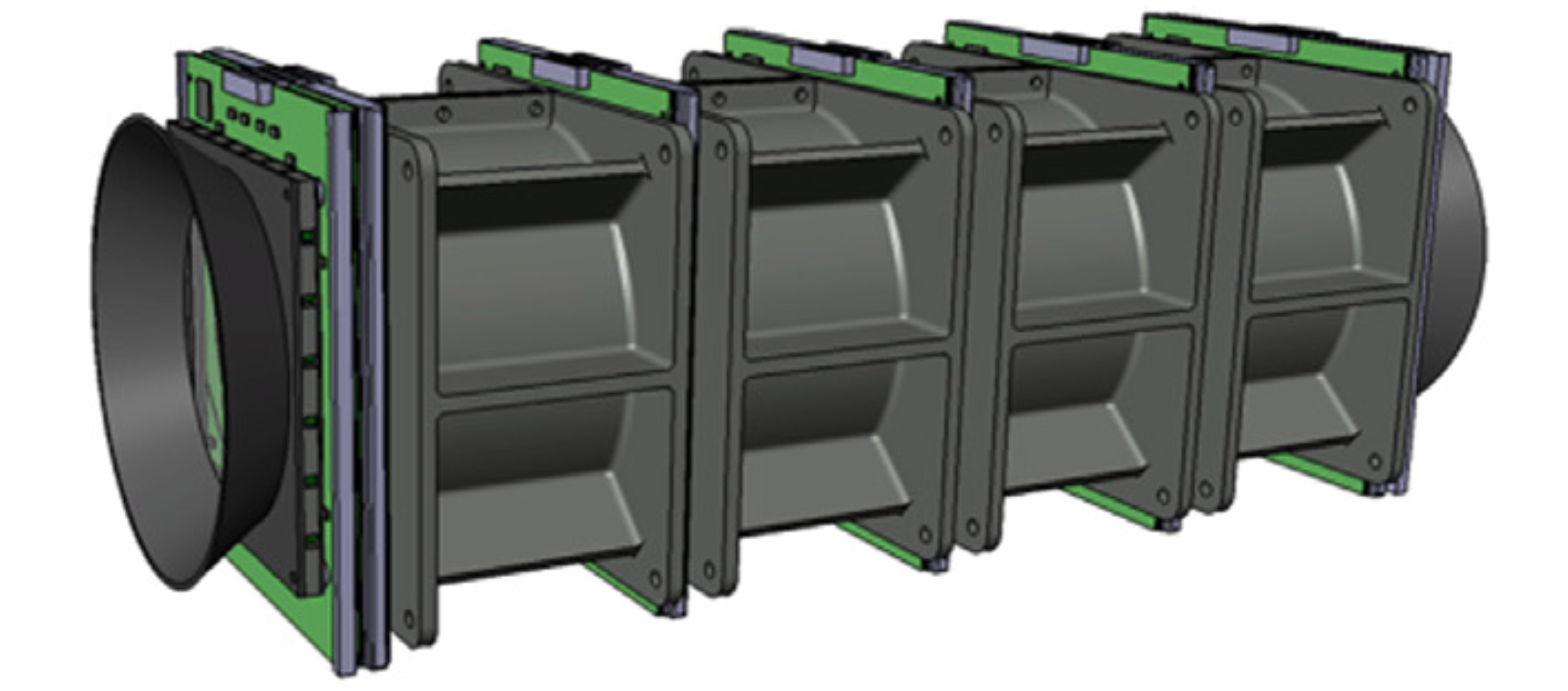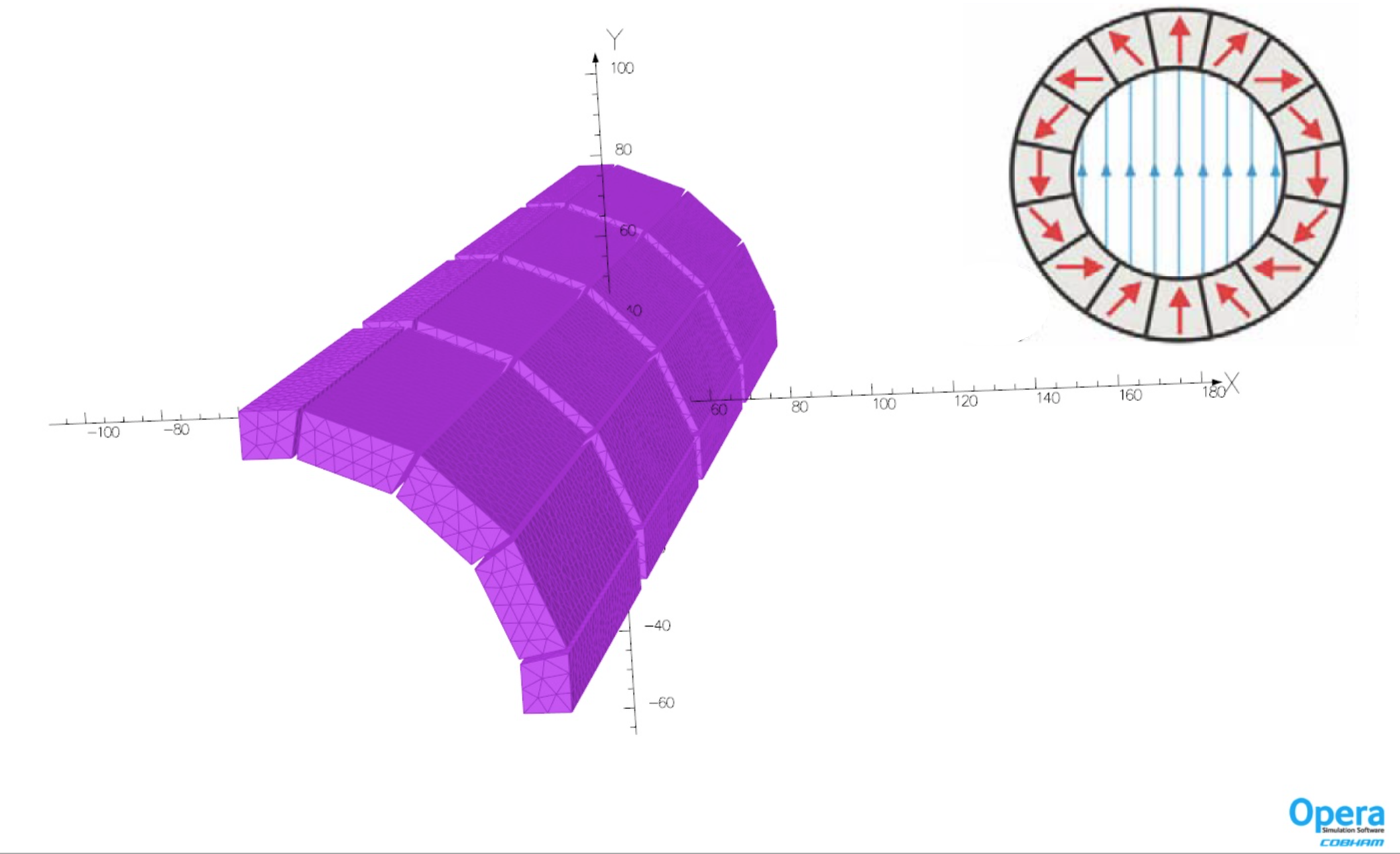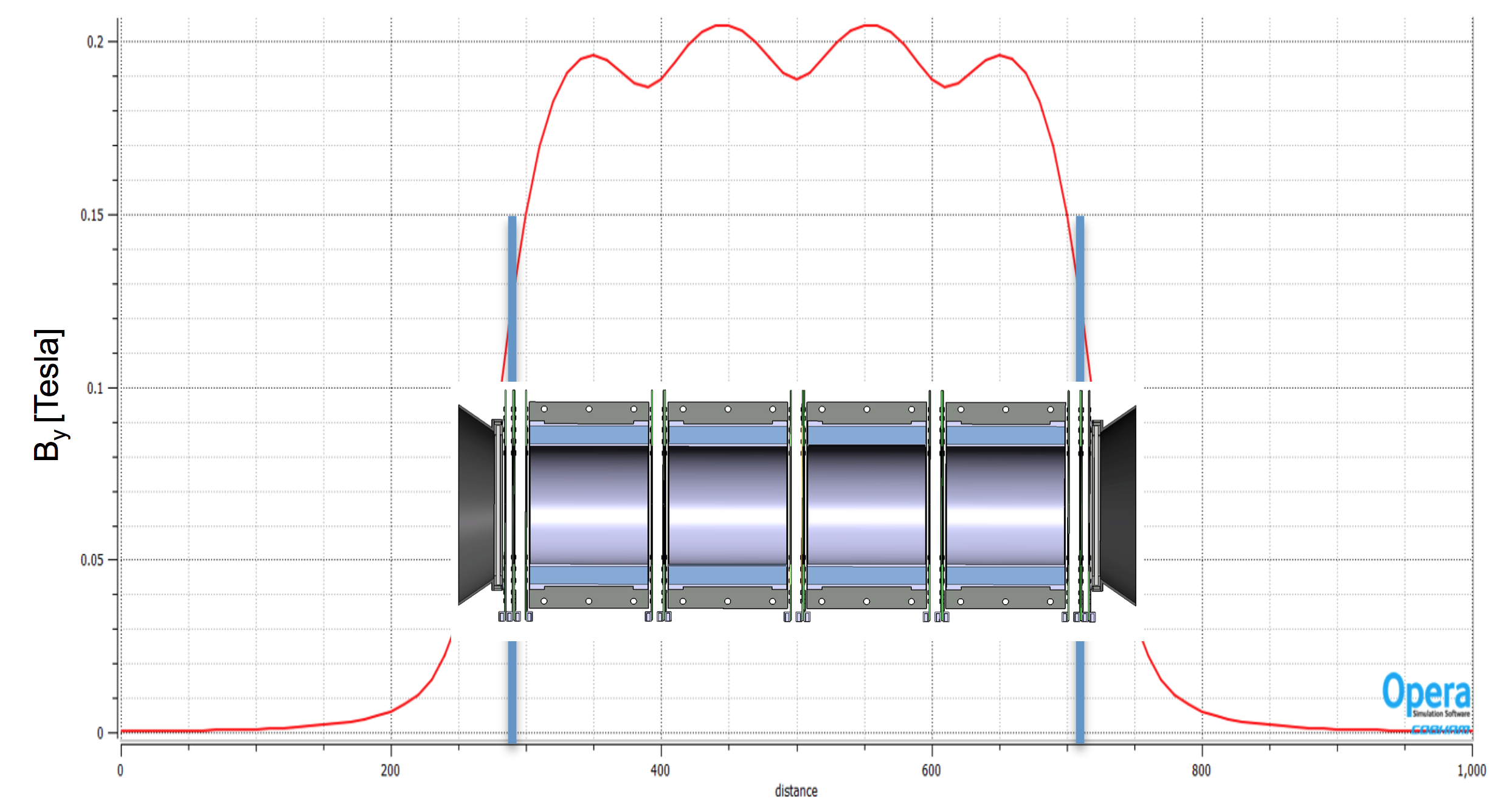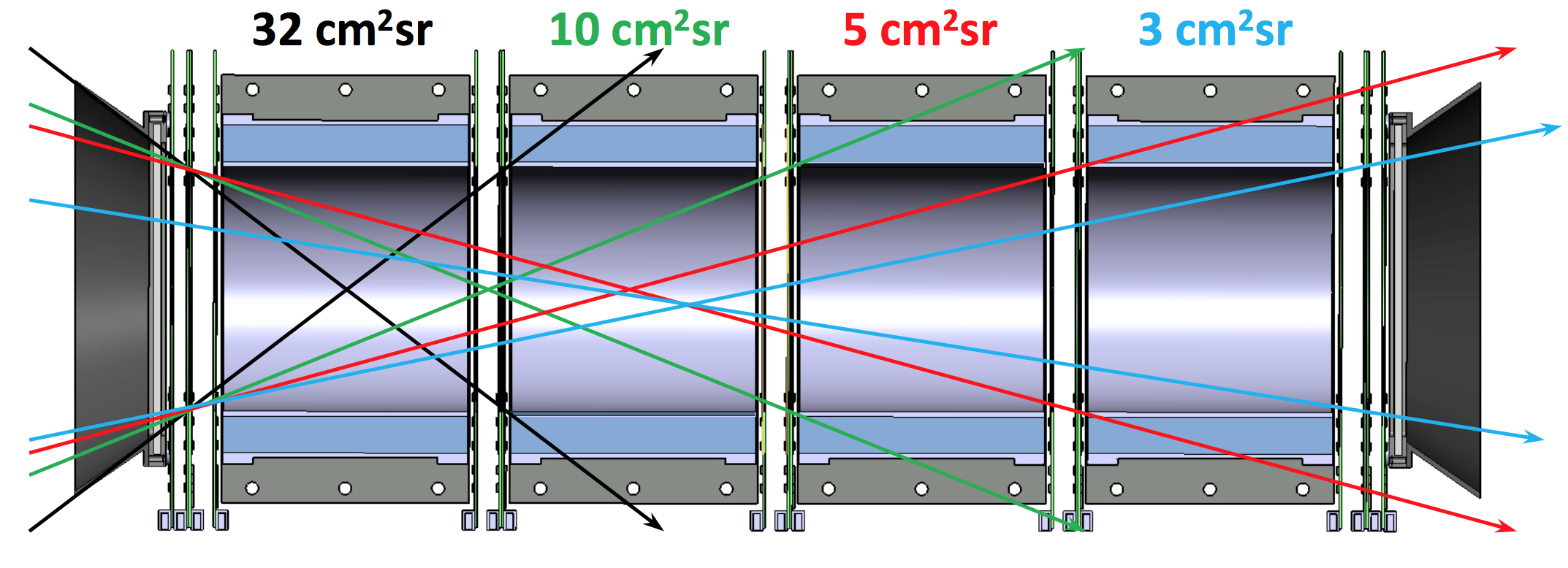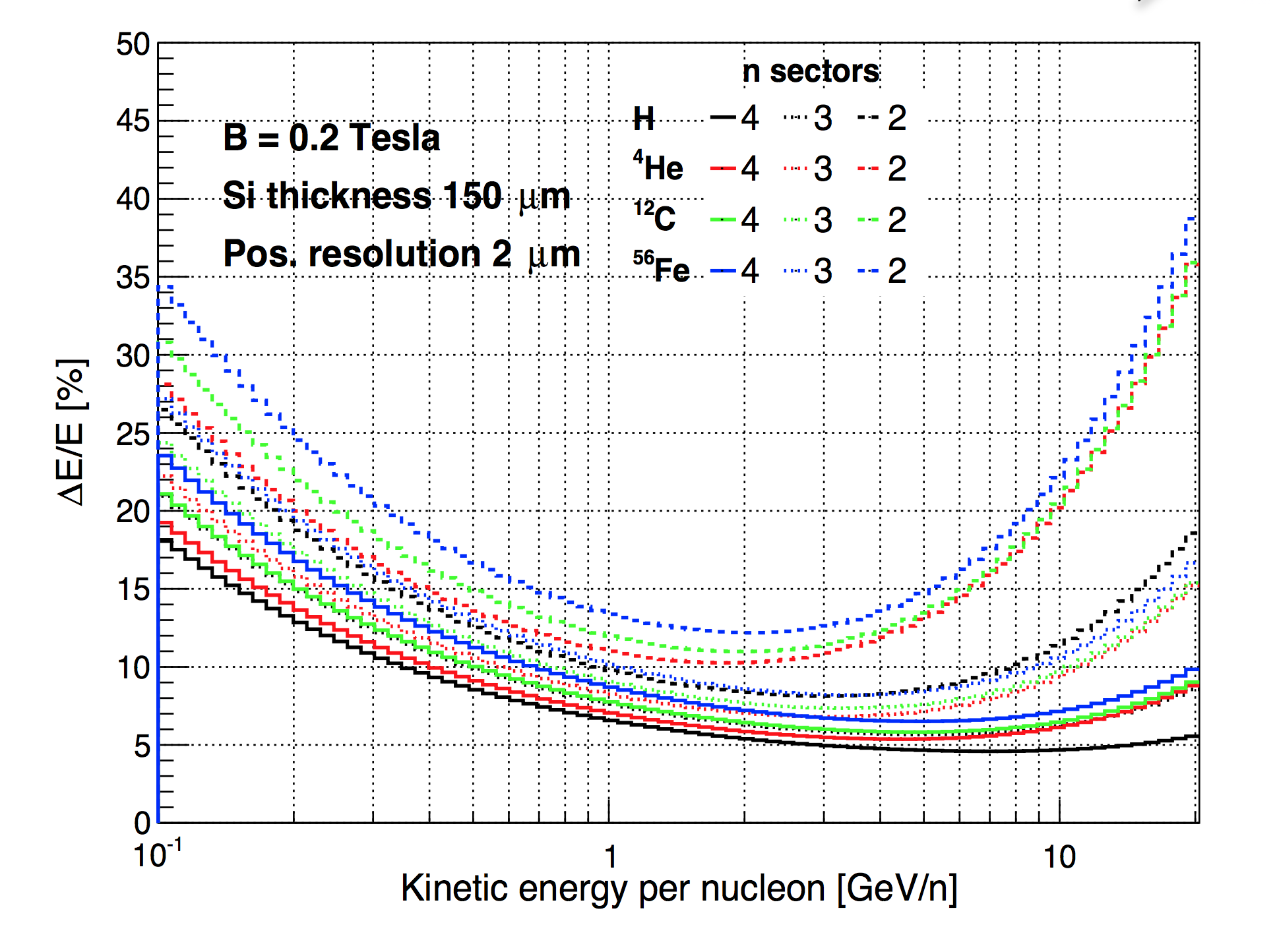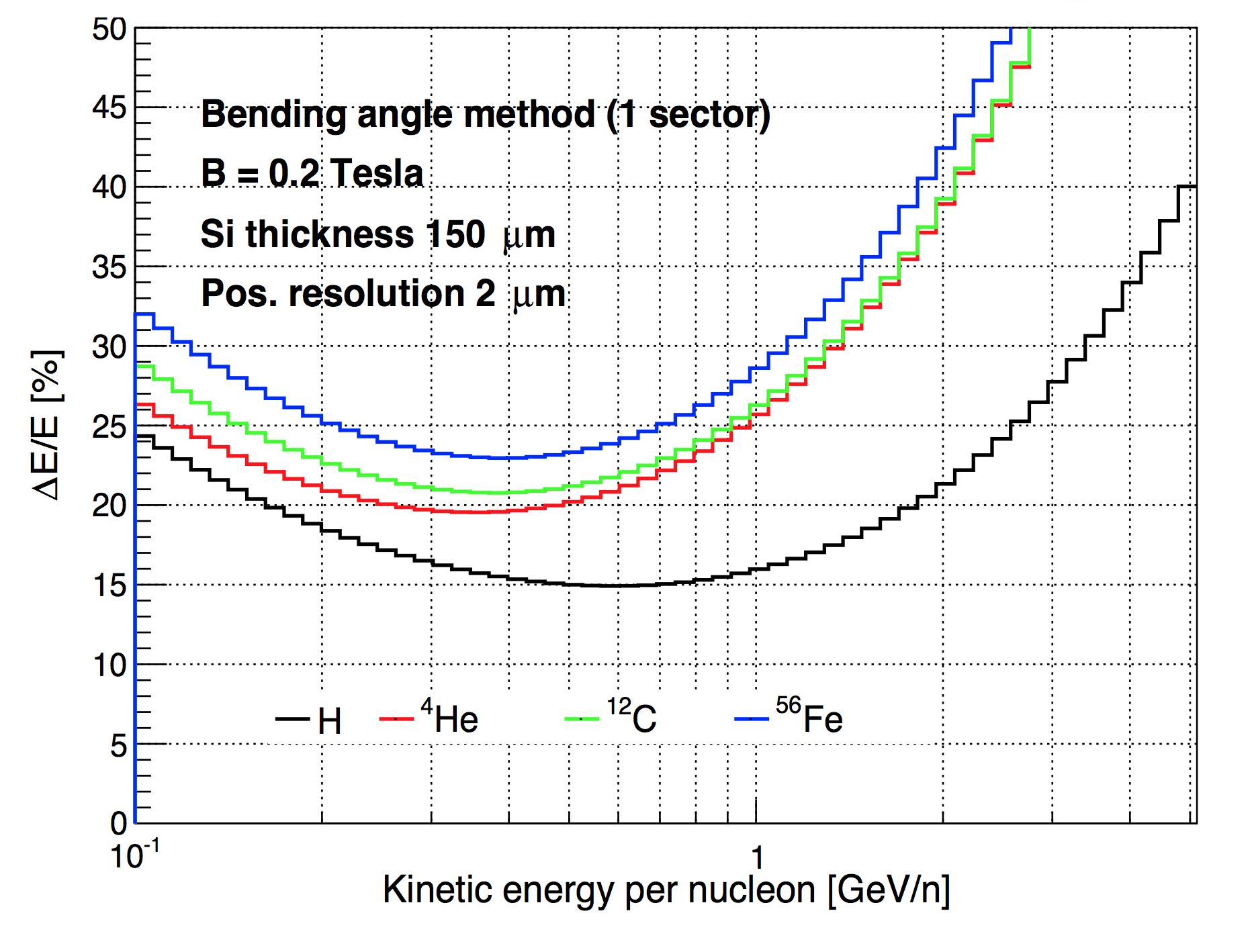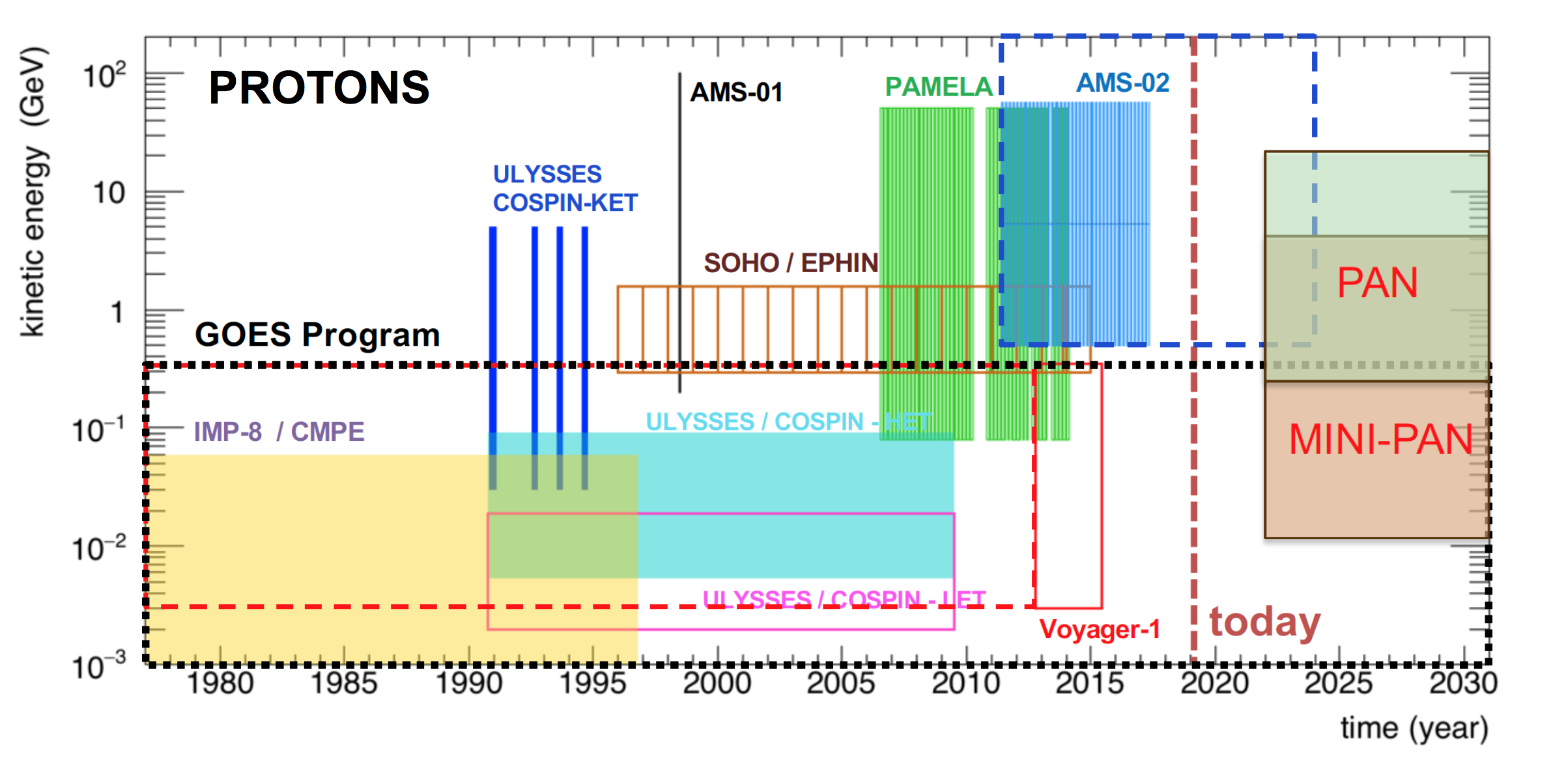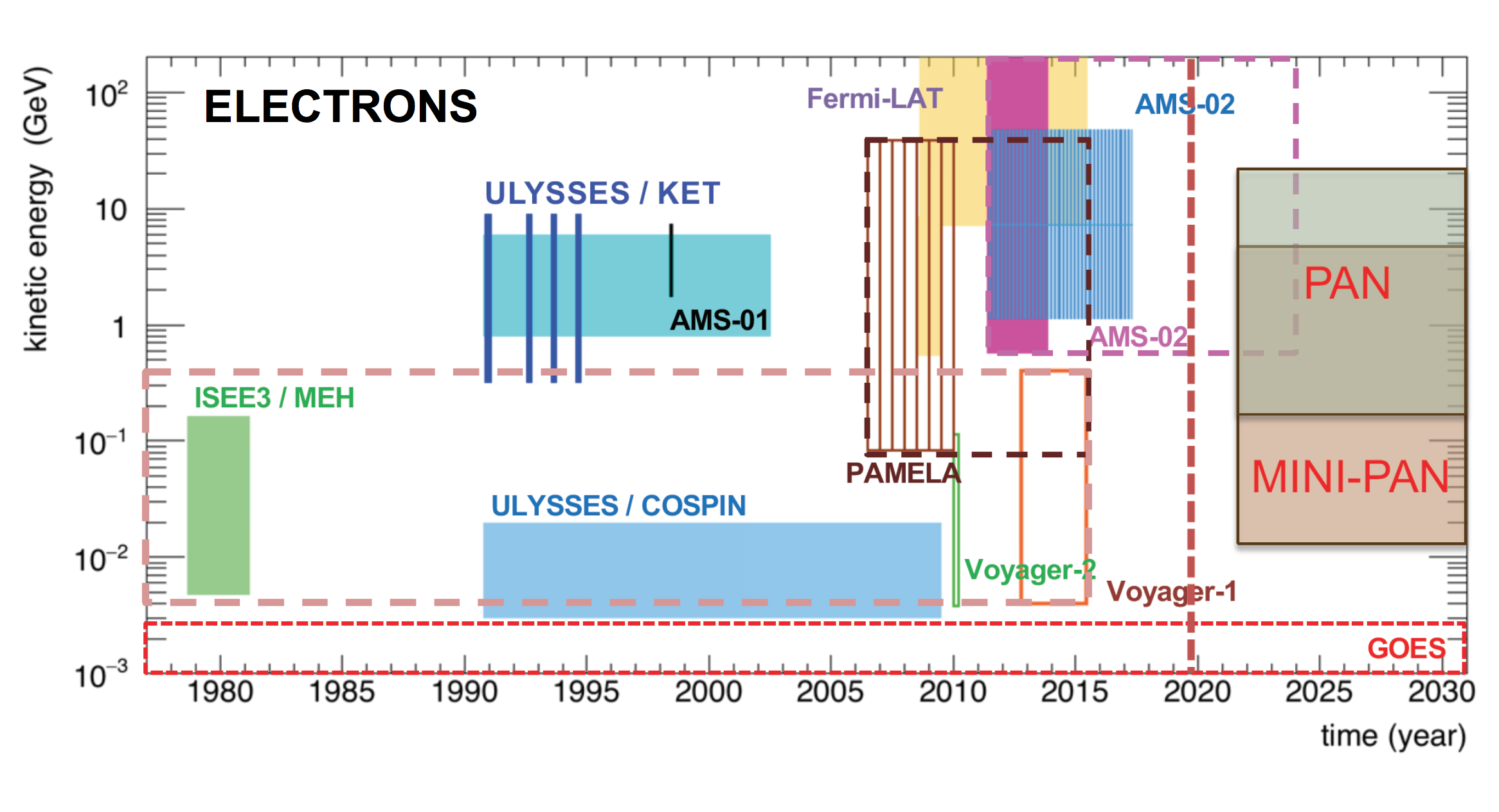
Penetrating particle ANalyzer
(PAN)
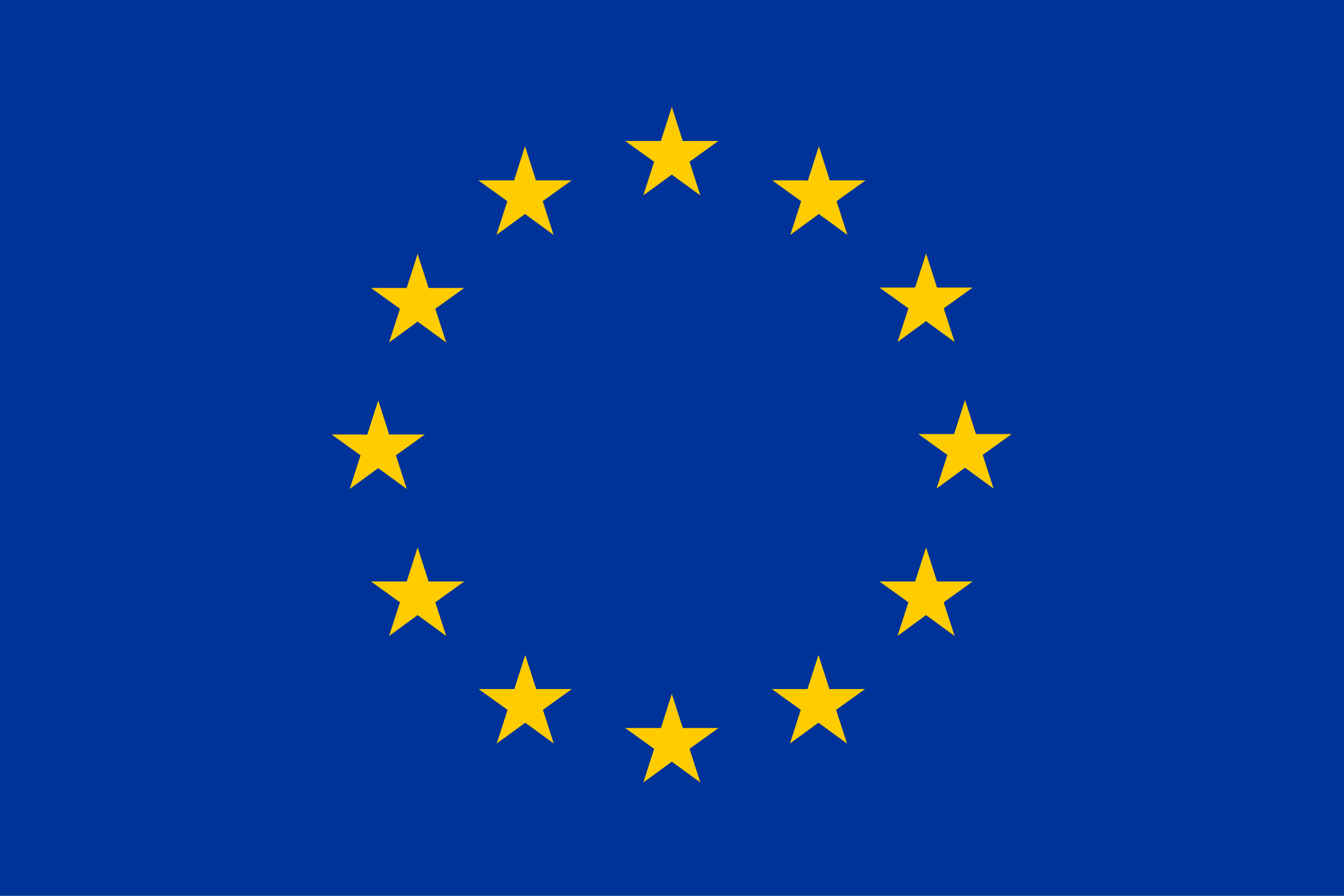
This project has received funding from the European Union's Horizon 2020 research and innovation programme under grant agreement No 862044.
PAN is an instrument
conceived to precisely measure the flux, composition and arrival
direction of highly penetrating particles in space of energy ranging
from 100 MeV/n to 20 GeV/n. The design is based on a modular magnetic
spectrometer of small size, reduced power consumption and weight which
make it suitable for deep space and interplanetary missions.
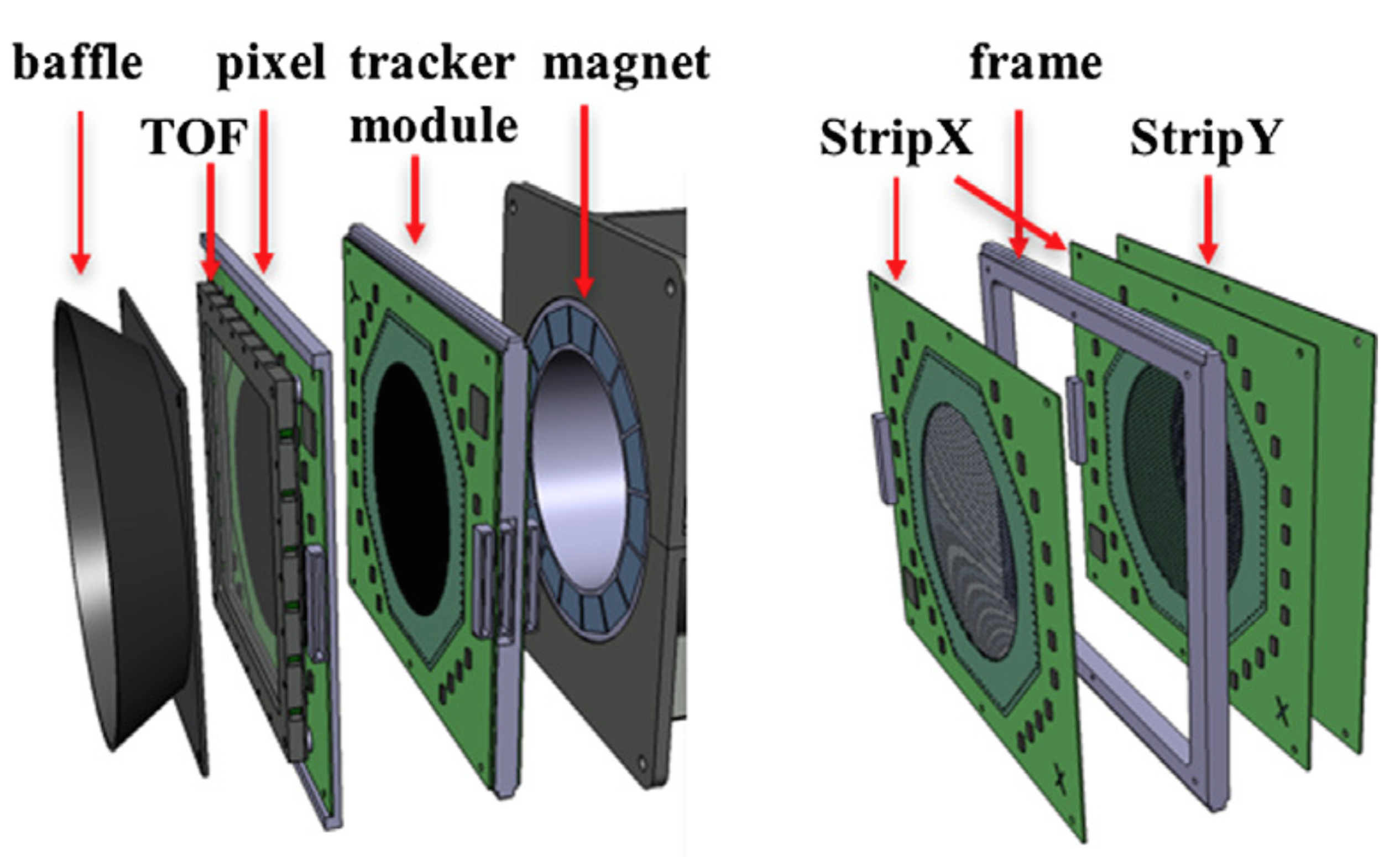
Science objectives:
Energetic particles in space can be
emitted by the Sun, as Solar Energetic Particles (SEPs), or by galactic
sources, as Galactic Cosmic Rays. Trapped populations are also found in
planetary magnetospheres. Precise measurements of their energy spectra
and composition in the 100 MeV/n to 20 GeV/n energy range are of great
interest to study Solar Modulation of Cosmic Rays, to characterise SEPs,
as well as the radiation environment around planets and to improve
Space Weather predictions for Deep Space travels.
Particles of energies above 100 MeV/n are highly penetrating, thus the only viable detection technique is by a magnetic spectrometer. However magnetic spectrometers in space have currently only be deployed in Low-Earth missions (Pamela and AMS), while all the deep space instruments rely on the dE/dx vs E method, which requires the particle to stop in the detector material. The PAN instrument aims at filling the current observational gap in deep space radiation monitoring proposing a modular spectrometer suitable for long distance missions.
Mini.PAN: the demonstrator
Mini.PAN detector layout
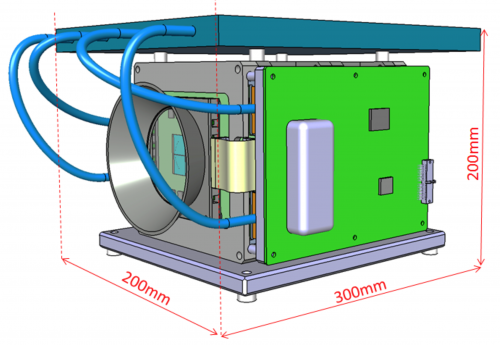
Mini.PAN detector open view
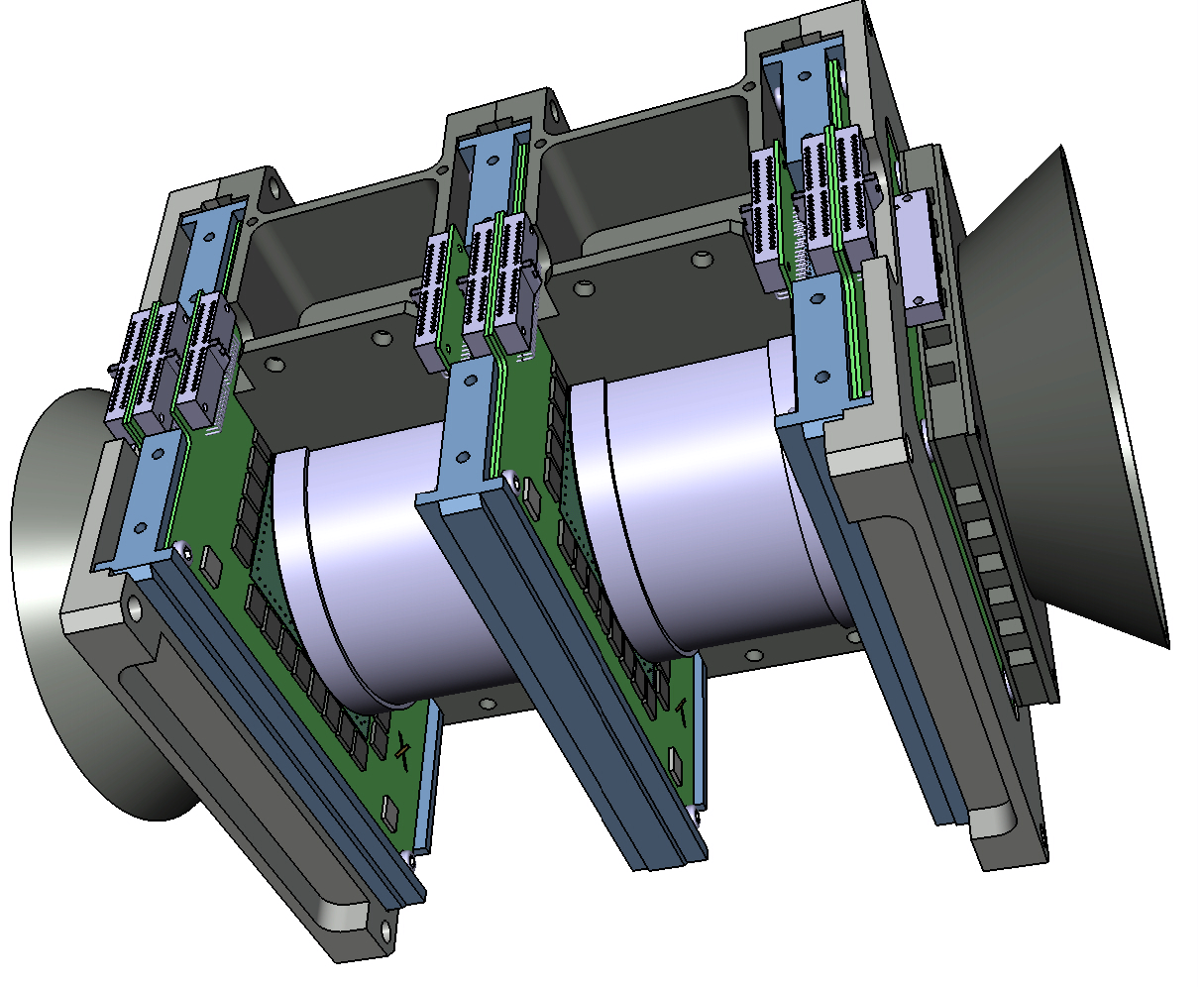
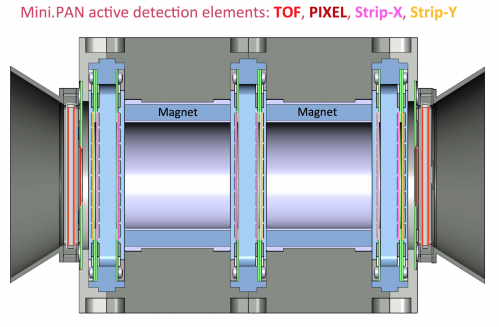
The development of a demonstrator, Mini.PAN, has been funded by a grant from the European Commission within the H2020 Future and Emerging Technologies, FET, program. The objective of this experiment is the in-orbit validation of the key functionality of the instrument. Mini.PAN is a small version of PAN, with a target mass of less than 10 kg and maximal power consumption of about 20W, it will feature two magnetic sectors made of permanent magnets, three stations of silicon-microstrip sensors at each end of the magnetic sectors and in between the two magnets, and two stations of Time Of Flight (TOF) scintillators and Pixel detectors at each end of the instrument. As PAN, mini.PAN is a modular spectrometer: particles entering one or both sectors can be analyzed and their energy measured exploiting the bending angle and the bending radius methods respectively. The geometrical acceptance for particles traversing only 1 magnetic sector is 6.3 cm2 sr, while for particles traversing the entire instrument is of 2.1 cm2 sr.
Mini.PAN Pixel
![]()
Mini.PAN Magnet sector
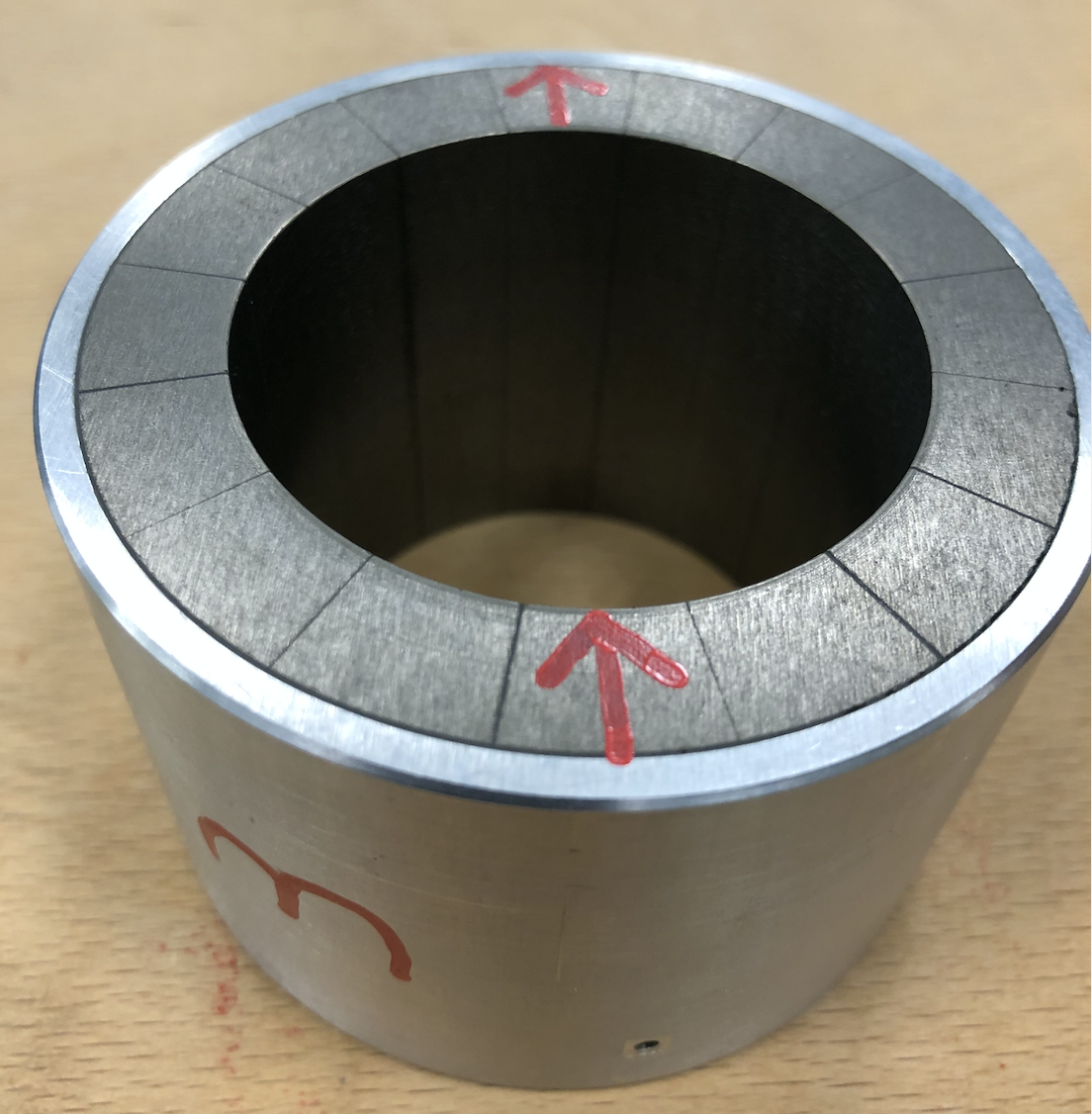
Mini.PAN TOF
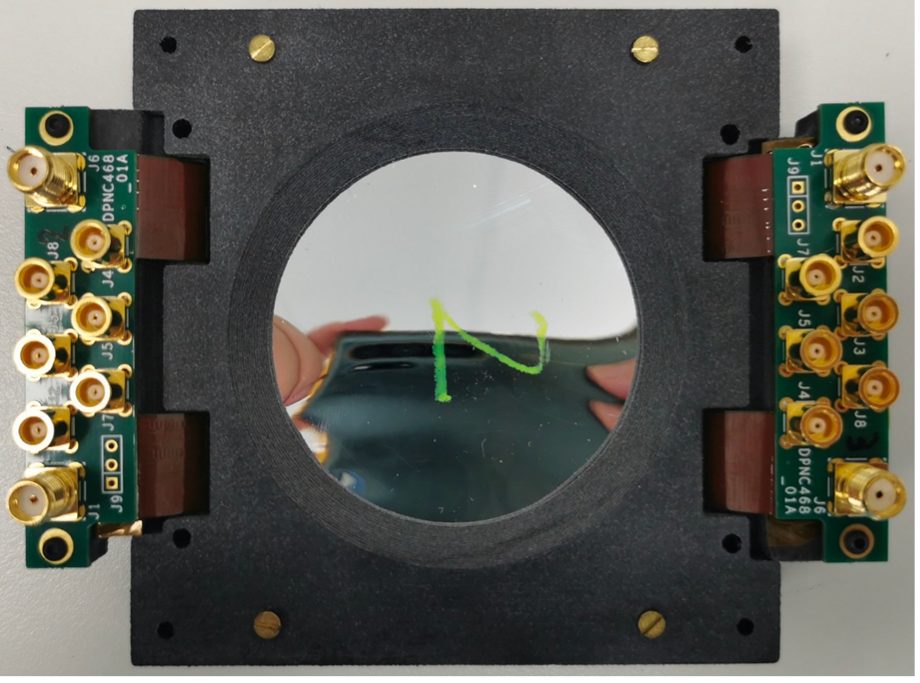
Mini.PAN Magnet inside support structure
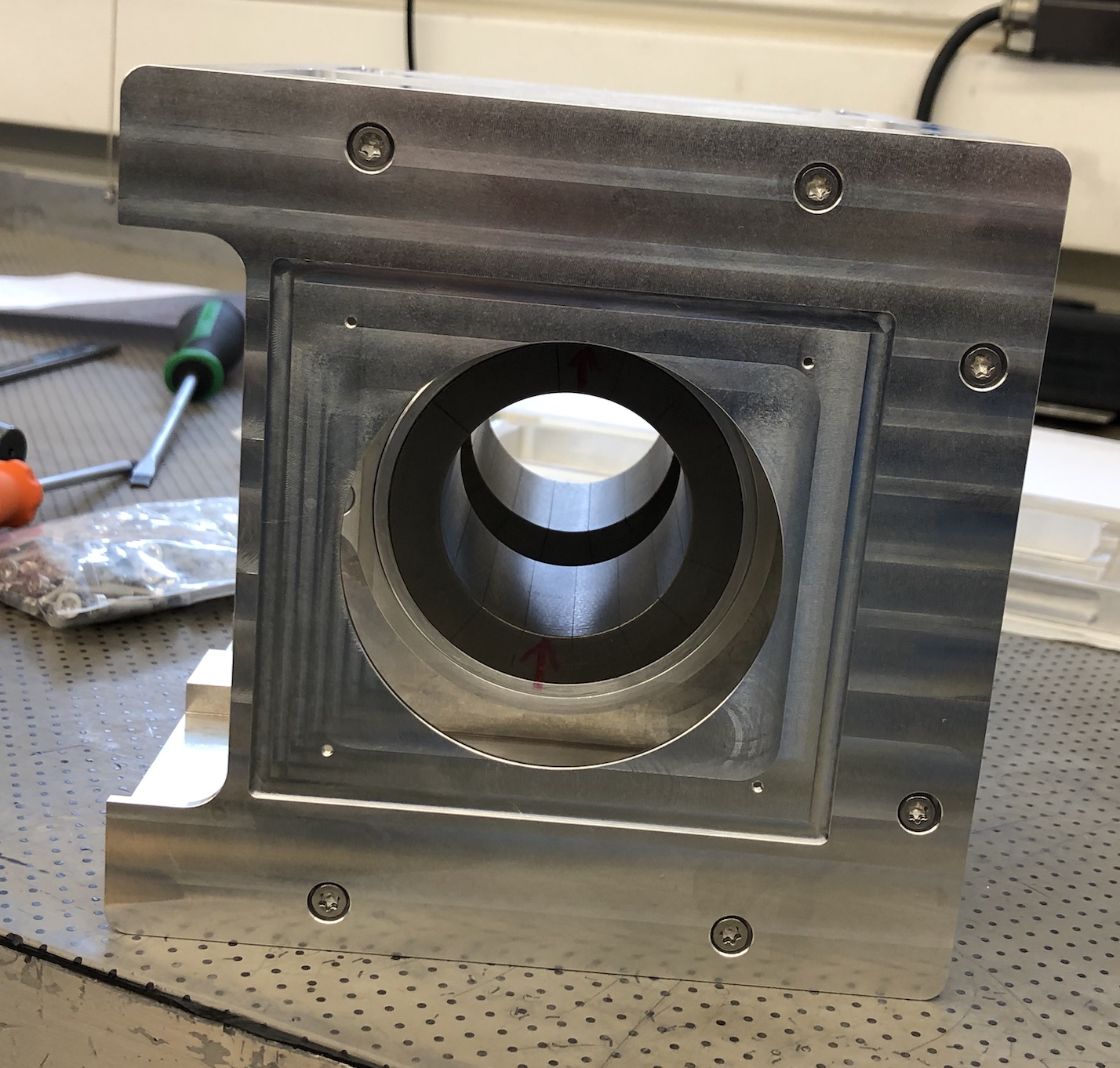
Mini.PAN Tracker StripX detector
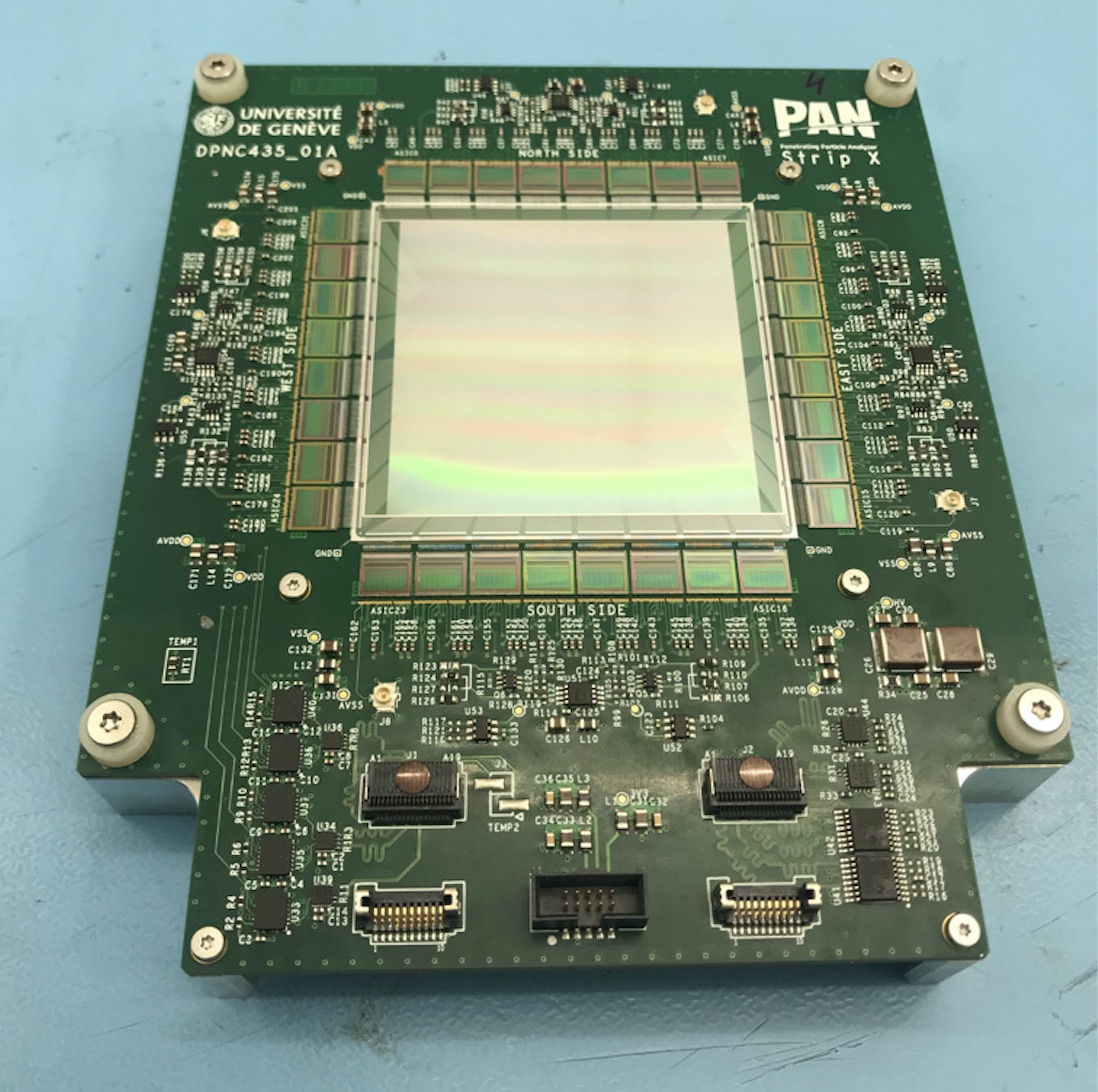
Mini.PAN spectrometer: Magnet with six StripX detectors
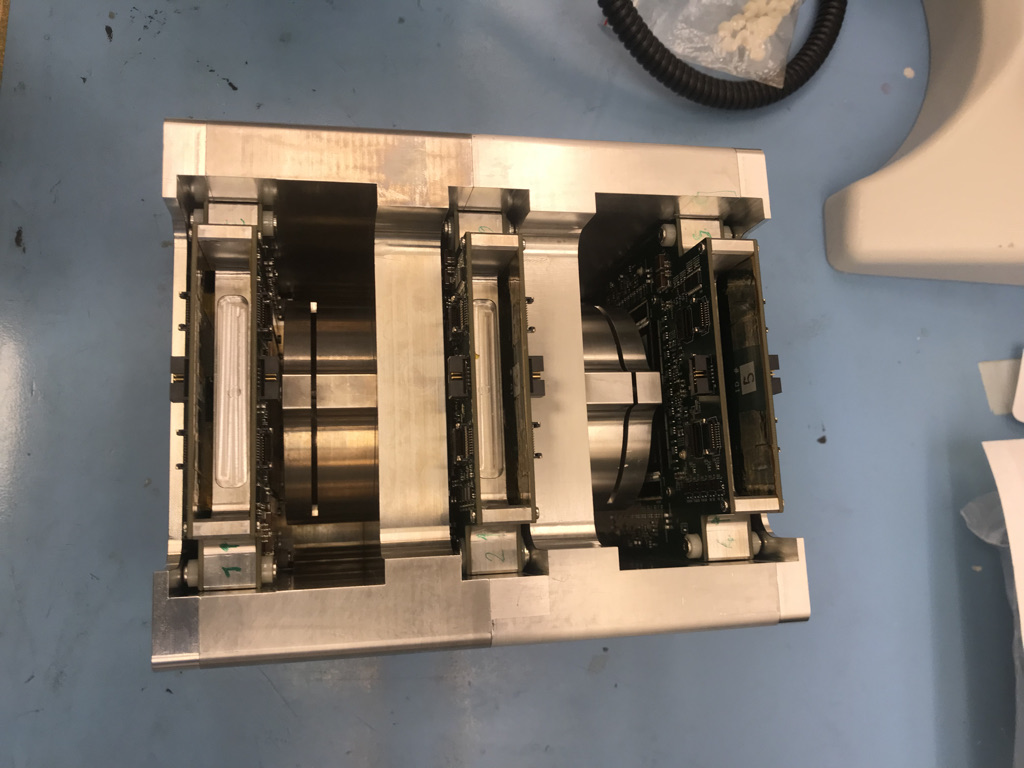
Mini.PAN read-out electronics
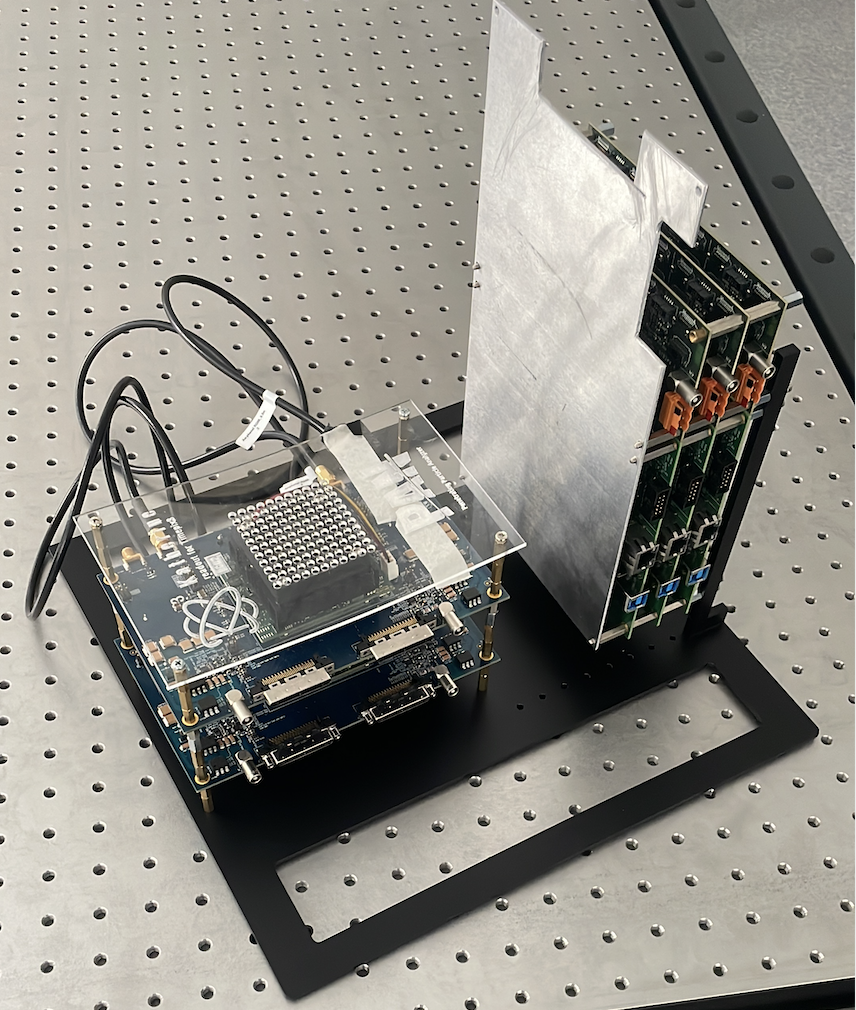
Mini.PAN Assembly inside black box
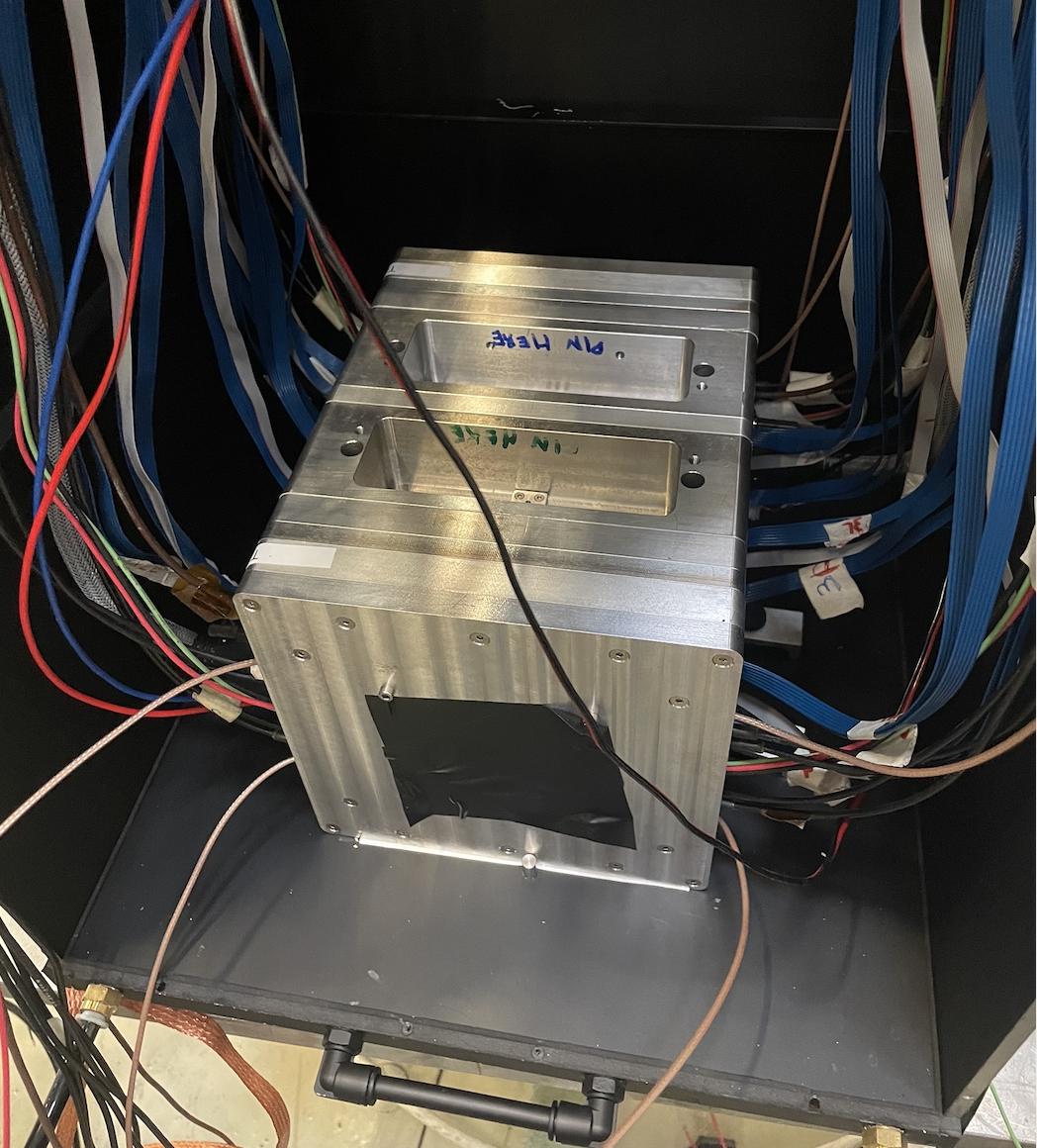
Mini.PAN and its read-out electronics
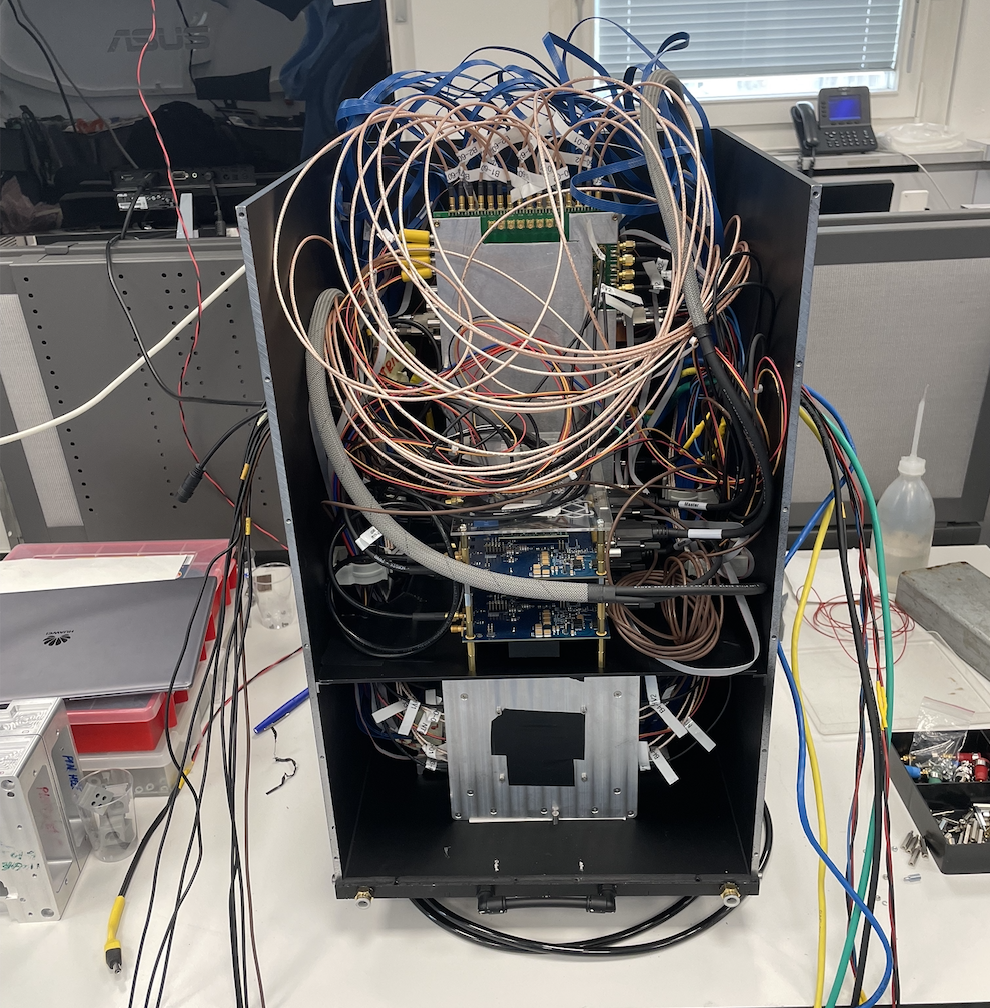
Mini.PAN Assembly video
;Collaborating Institutes and Members
Departement of Nuclear and Particle Physics (DPNC), University of Geneva, Switzerland
Xin Wu (Principal Investigator), Philipp Azzarello, Mercedes Paniccia, Merlin Kole, Johannes Hulsman, Tomoya Iizawa, Daniil Sukhonos, Pengwei Xie, Franck Cadoux, Laurent Nicola, Yannick Favre, Daniel Lamarra, Jerome Stauffer, Adrien Stil
National Institute of Nuclear Physics (INFN), Perugia Section , Perugia Italy
Giovanni Ambrosi, Bruna Bertucci, Maria Ionica, Matteo Duranti, Maura Graziani, Nicola Tomassetti, Lorenzo Mussolin, Mirco Caprai, Fabio Cosso, Mattia Barbanera, Edoardo Mancini
Institute of Experimental and Applied Physics (IEAP), Czech Technical University in Prague, Prague, The Czech Republic
Benedikt Bergmann, Petr Burian, M. Farkas, Jindra Jelinek, Milan Malich, Petr Manek, Stefan Gohl, Stanislav Pospisil, Petr Smolyanskiy
Talks & Seminars
LunPAN: Comprehensive study of the lunar energetic particle environment speaker: X.Wu, Swiss Small Satellite Forum, November 23, 2023 (Switzerland) Talk
Penetrating particle ANalyzer (PAN) speaker: G.Silvestre, VERTEX 2023: 32nd International workshop on Vertex Detectors October, 16-20,2023, Sestri Levante (Italy) Talk
Pix.PAN: versatile instrument for particle environment studies on the lunar surface speaker: X.Wu, First Lunar Plasma Interdisciplinary Network Workshop, September 4-8, 2023, Björkliden (Sweden) Talk
Penetrating particle ANalyzer (PAN) speaker: D.Sukhonos, ICRC2023: 38th International Cosmic Ray Conference, 26 July - 3 August 2023, Nagoya (Japan) Proceedings
Characterization of a large area hybrid pixel detector of Timepix3 technology for space applications speaker: M.Farkas, ASAPP2023: Advances in Space AstroParticle Physics: frontier technologies for particle measurements in space, June 19-23, 2023, Perugia (Italy) slides
PAN: mission status and prospects speaker: Ph.Azzarello, ASAPP2023: Advances in Space AstroParticle Physics: frontier technologies for particle measurements in space, June 19-23, 2023, Perugia (Italy) slides
Development of a Penetrating particle ANalyzer for high-energy radiation measurements in deep space speaker: P.Xie, SPACEMON2023: Space Environment Monitoring workshop, 15-17 May 2023, ESA-ESTEC slides
REMEC: a small deep space mission dedicated to precise energetic particle measurements and monitoring speaker: X.Wu, 5th COSPAR Symposium, April 16-21, 2023, Singapore slides
Mini.PAN: real-time penetrating partcile flux monitoring with a compact high precision magnetic spectrometer speaker: X.Wu, COSPAR2022: 44th Scientific Assembly - F2.3: Space Radiations: Dosimetric Measurements and Related Models, Detector Developments and Ground-Based Characterization,16-24 July, 2022, Athens (Greece) Talk
Mini.PAN: compact magnetic spectrometer for precise energetic particle measurements for lunar science and exploration Presenter: X.Wu, COSPAR2022: 44th Scientific Assembly - B3.1: Lunar Science and Exploration,16-24 July, 2022, Athens (Greece) Poster
Development of a Penetrating particle ANalyzer (PAN) demonstrator and the results from beam tests speaker: T.Izawa, SPS2022: Annual Meeting of the Swiss Physical Society,June 27-30, 2022, Fribourg (Switzerland) slides
Characterization of a Timepix3 quad for space application in the penetrating particle analyzer (PAN) speaker: P.Burian, IWORID2022: 23rd International Workshop on Radiation Imaging Detectors,June 26-30, 2022 Riva del Grade (Italy) slides
Space-flight readiness assessment of the PAN demonstrator mechanical design speaker: E.Mancini, Forum on Tracker Detectors Mechanics 2022,June 8-10, 2022, LNF Frascati (Italy) slides
Penetrating particle ANalyzer: Silicon tracker development and beamtest results speaker: M.Duranti, PM2021: 15th Pisa Meeting on Advanced Detectors, May 22-28, 2022, Isola d’Elba (Italy) slides
The Silicon Microstrip Tracker for the Mini.PAN experiment speaker: M.Ionica, PM2021: 15th Pisa Meeting on Advanced Detectors, May 22-28, 2022, Isola d’Elba (Italy) Poster
Penetrating particle ANalyzer: Silicon tracker development and beamtest results speaker: D.Sukhonos, 17th (Virtual) Trento Workshop on Advanced Silicon Radiation Detectors, 2-4 March 2022, University of Freiburg (Virtual), slides
Mini.PAN: Real-Time Penetrating Particle Analyzer for ARTEMIS speaker: X.Wu, XIV Lunar Surface Science Workshop: Heliophysics Applications Enabling and Enabled by Human Exploration of the Lunar Surface, February 17, 2022, Virtual Poster
Development of a Penetrating particle ANalyzer for high-energy radiation measurements in space speaker: Ph.Azzarello, PSD12: The 12th International Conference on Position Sensitive Detectors, September 2021, slides
The high resolution PAN detector for deep space cosmic-ray particles measurements speaker: M.Ionica, TIPP 2021, slides
Exploring Deep Space science with the Penetrating particle ANalyzer speaker: P.Xie, Annual Plenary Meeting of the Swiss Institute of Particle Physics CHIPP 2021, slides
Development of a Penetrating particle ANalyzer for high-energy radiation measurements in space speaker: M.Duranti, COSPAR 2020, slides
Development of a Penetrating particle ANalyzer for high-energy radiation measurements in deep space and interplanetary missions speaker: B.Bergmann, IAC 2020, slides
Development of a Penetrating particle ANalyzer for deep space science speaker: P.Xie, SPACEMON 2020, slides
Development of a Penetrating particle ANalyzer for high-energy radiation measurements in space speaker: B.Bergmann, ICHEP 2020, slides
Project publications
Penetrating Particle ANalyzer (PAN) D.Sukhonos et al., Proceedings of 38th International Cosmic Ray Conference PoS(ICRC2023), 444, 045, (2023) https://doi.org/10.22323/1.444.0045
The Penetrating particle ANalyzer (PAN) instrument for measurements of low energy cosmic rays G.Ambrosi et al., In Proceedings of the IEEE Nuclear Science Symposium and Medical Imaging Conference 2019, published April 2020 https://doi.org/10.1109/nss/mic42101.2019.9059946
Penetrating particle ANalyzer (PAN) G. Silvestre et al, Submitted to Proceedings of the 32nd International Workshop on Vertex Detectors VERTEX 2023 https://pos.sissa.it/448/
Characterization of a large area hybrid pixel detector of Timepix3 technology for space applications M. Farkas et al, Submitted to Proceedings of the international conference Advances in Space AstroParticle Physics: Frontier Technologies for Particle Measurements in Space (ASAPP 2023) https://www.mdpi.com/journal/instruments/special_issues/44O4E85G84#
Related publications
Relativistic Particle Measurements in Jupiter’s Magnetosphere with Pix.PAN J. Hulsman, et al., Exp. Astron. (2023) https://doi.org/10.1007/s10686-023-09918-4
Tracking and separation of relativistic ions using Timepix3 with a 300um thick silicon sensor P. Smolyanskiy et al., JINST 16 P01022 (2021) https://doi.org/10.1088/1748-0221/16/01/P01022
Detector response and performance of a 500 μm thick GaAs attached to Timepix3 in relativistic particle beams B. Bergmann et al., JINST 15 C03013 (2020) https://doi.org/10.1088/1748-0221/15/03/C03013
Penetrating Particle ANalyzer (PAN) X.Wu et al., Adv. Space Res. 63, 8, 2672-2682 (2019) https://doi.org/10.1016/j.asr.2019.01.012
NEWS & EVENTS
Follow us on LinkedIn
PAN Final Review Meeting: February 23 2024, Villa Boninchi, Corsier, Switzerland
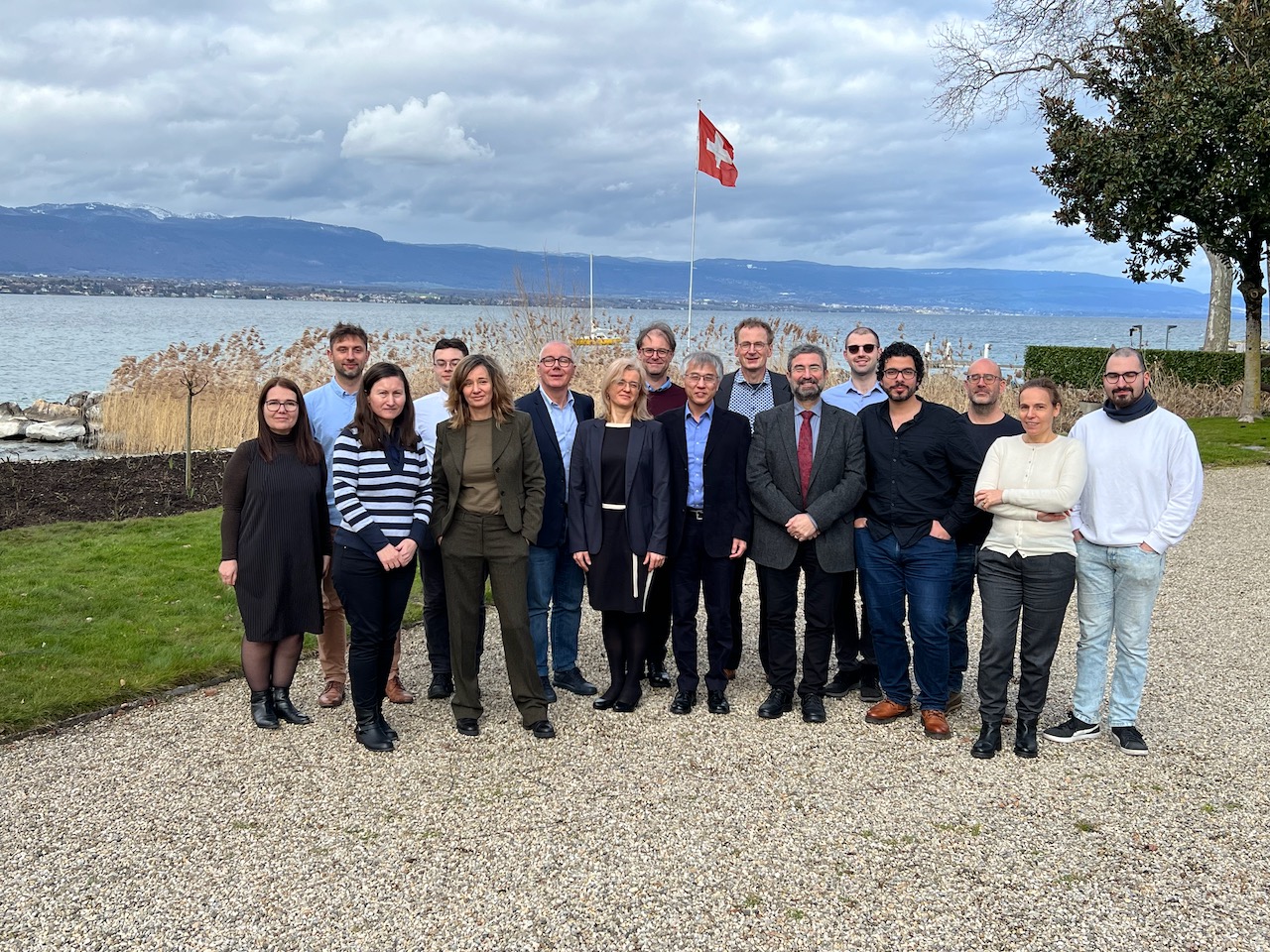
Third PAN Workshop: December 4-5 2023, University of Perugia, Italy
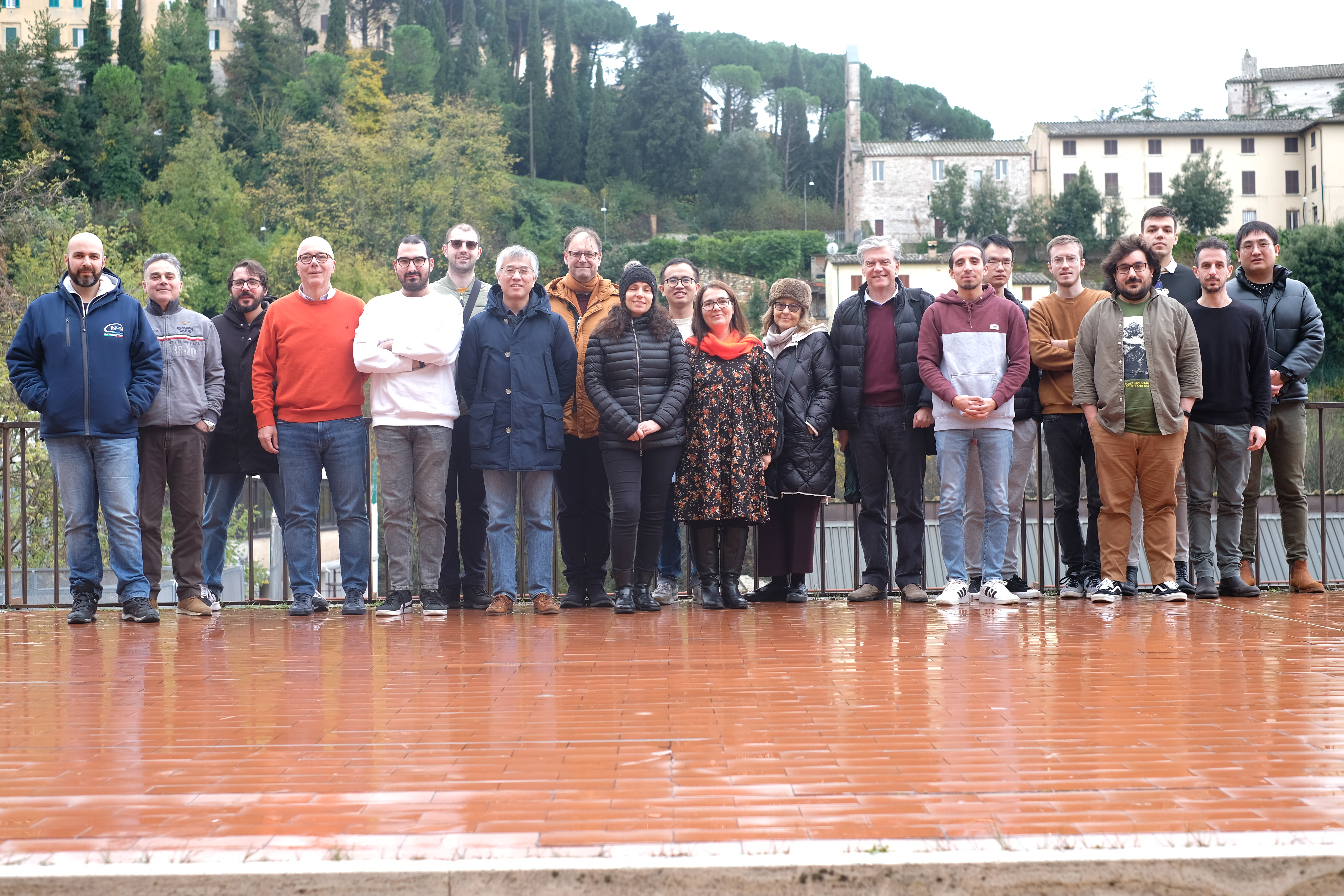
Mini.PAN at CERN Test beam April 2023
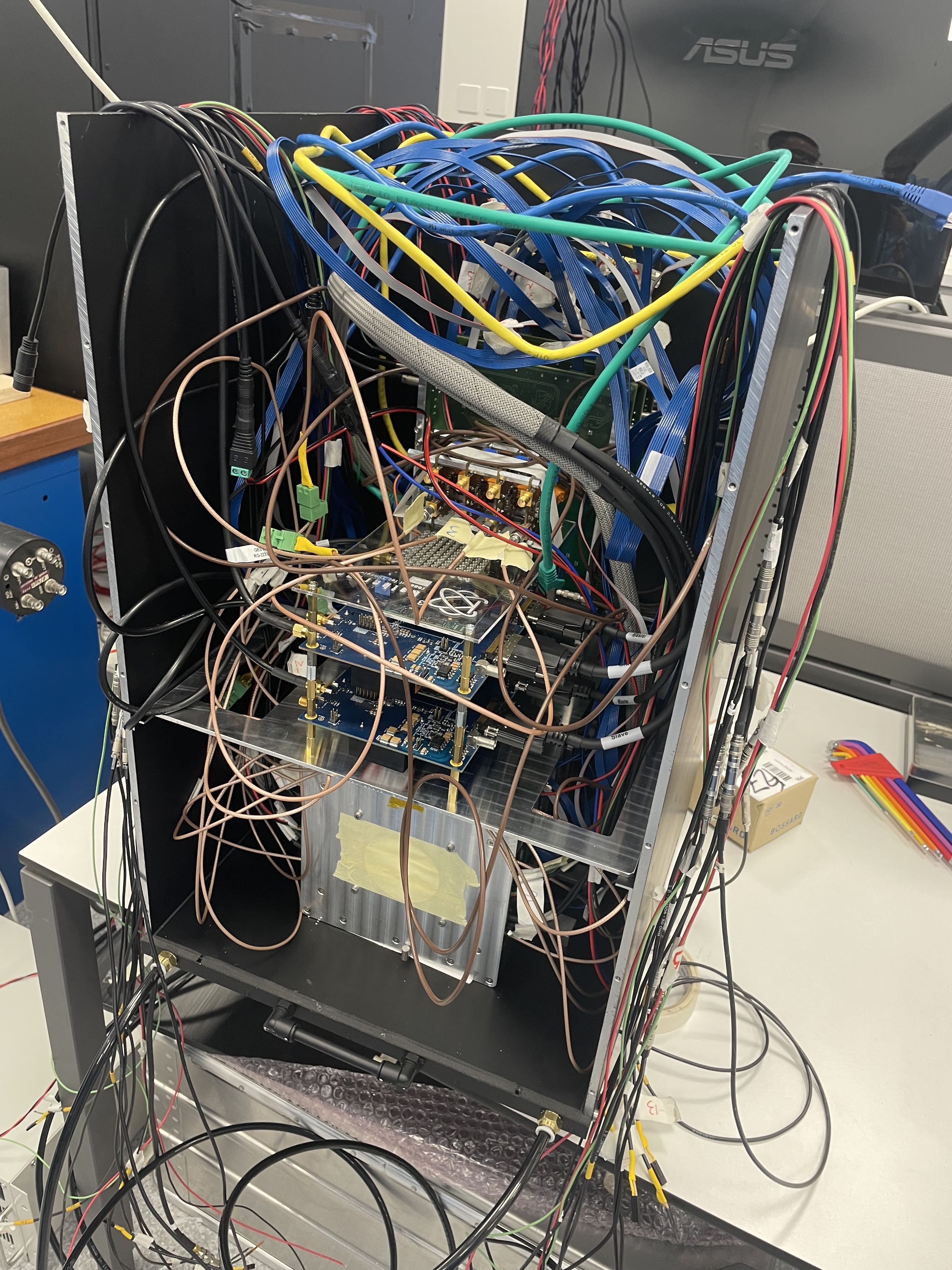
Mini.PAN at CERN Test beam November 2022
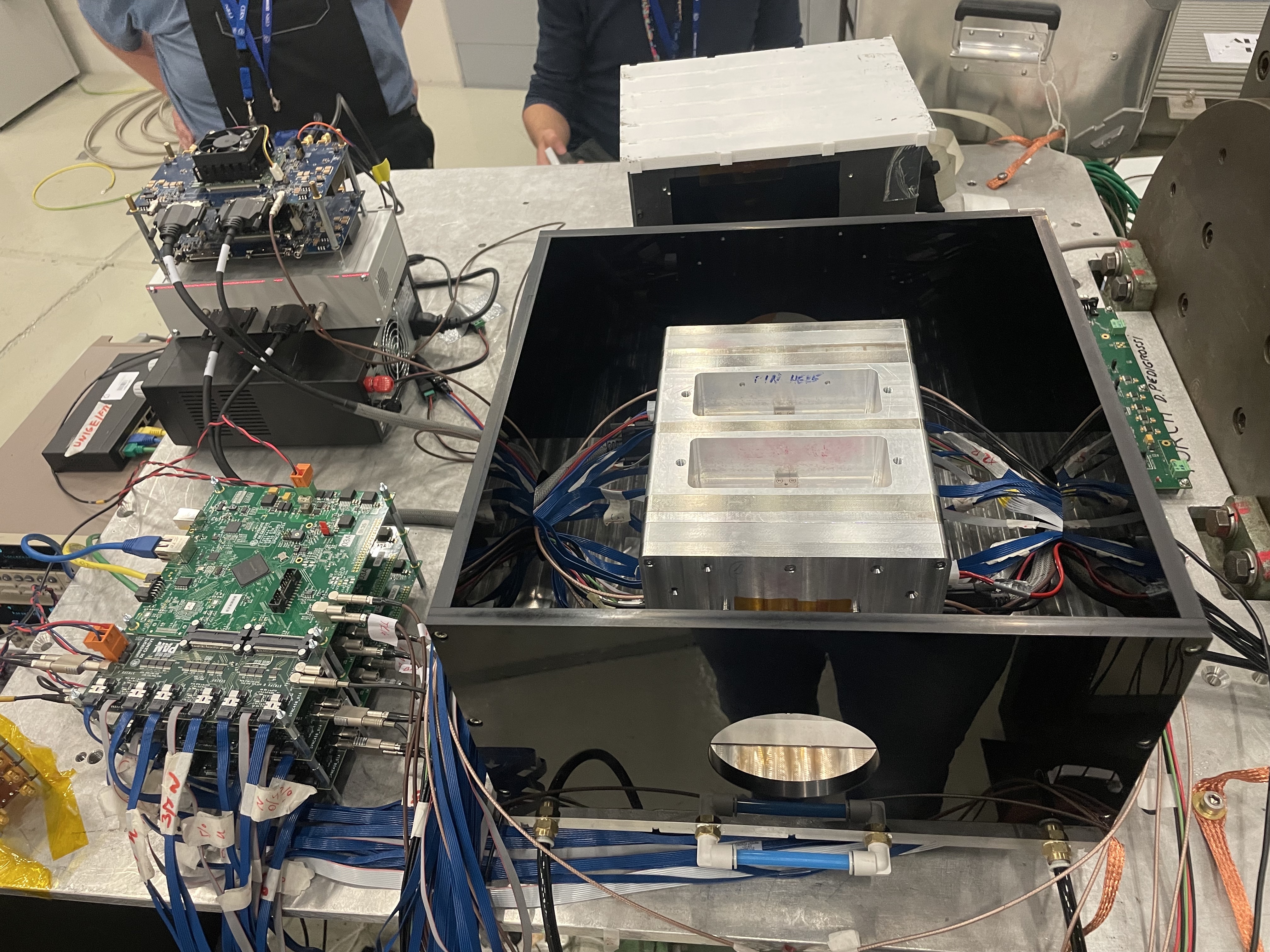
Mini.PAN spectrometer at CERN Test beam November 2021
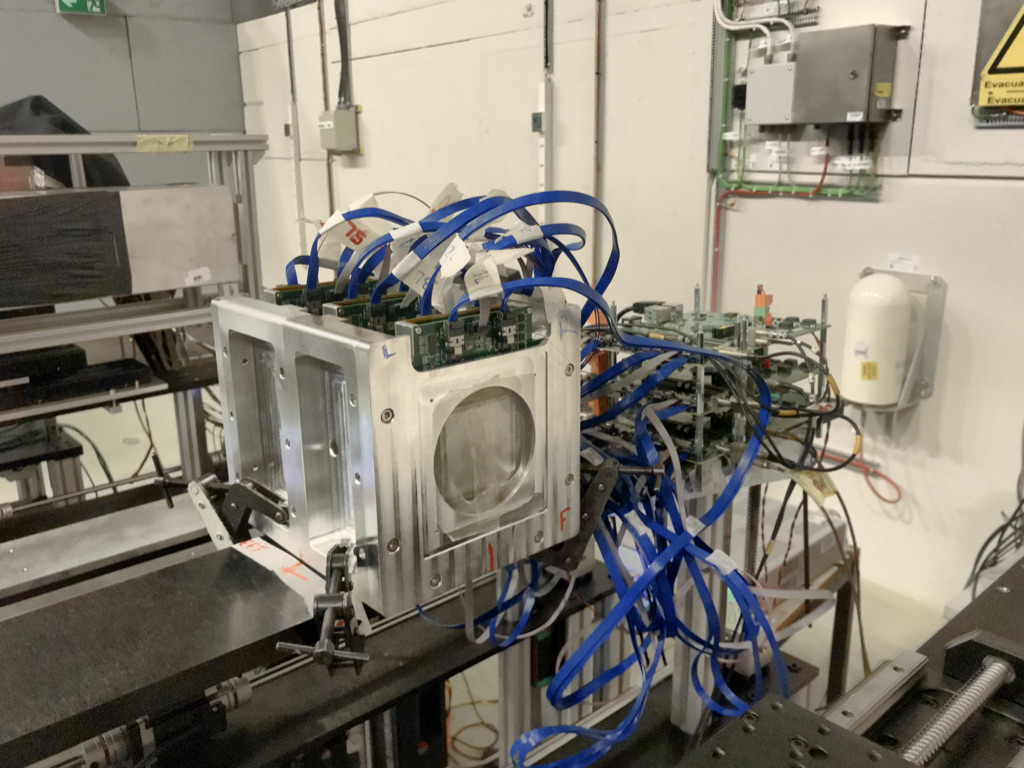
Second PAN Workshop: October 5-7 2021, Czech Technical University in Prague, The Czech Republic
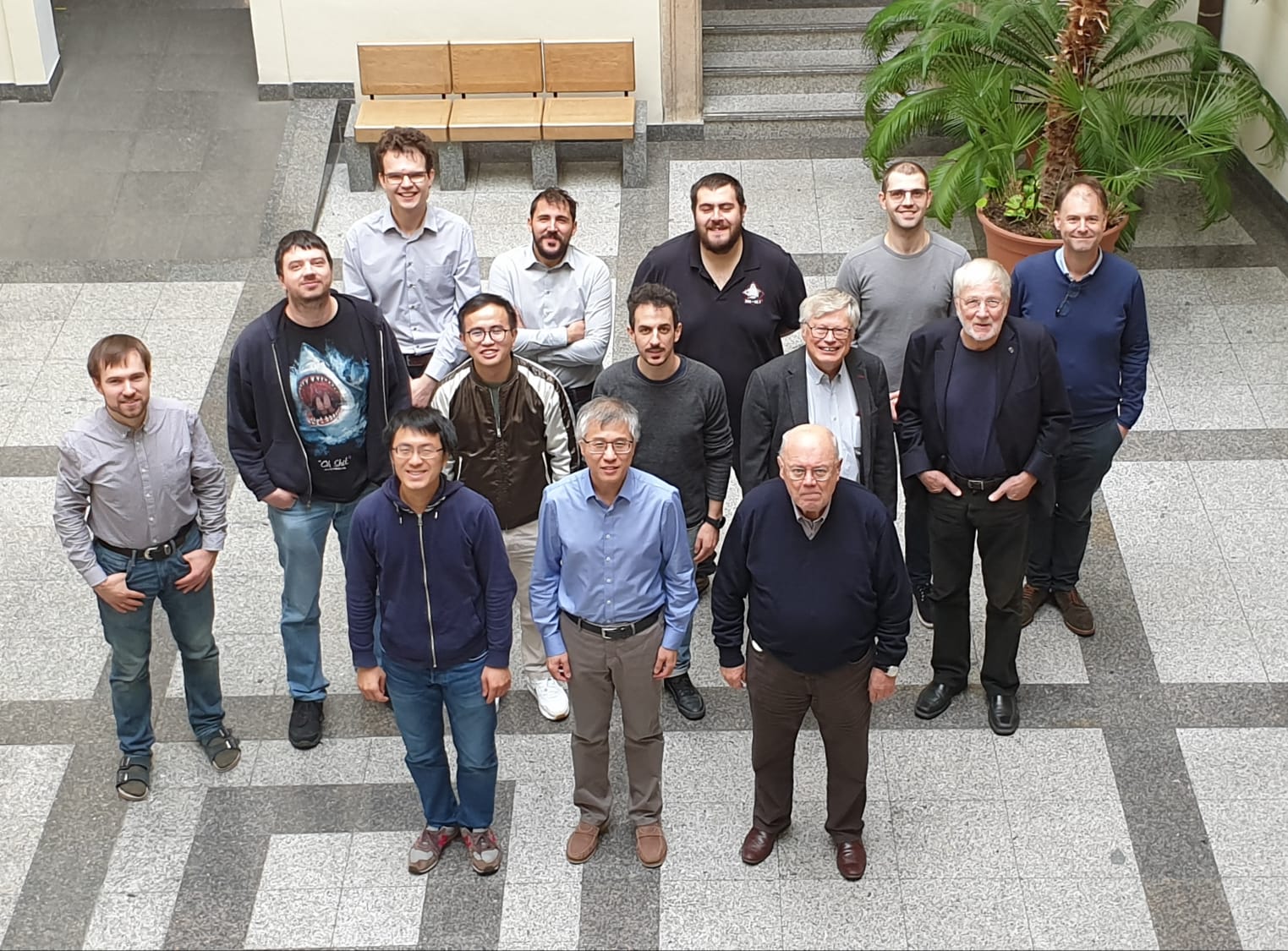
First PAN Workshop: Mini.PAN kick-off meeting January 21-22 2020, Villa Boninchi , Corsier Geneva, Switzerland
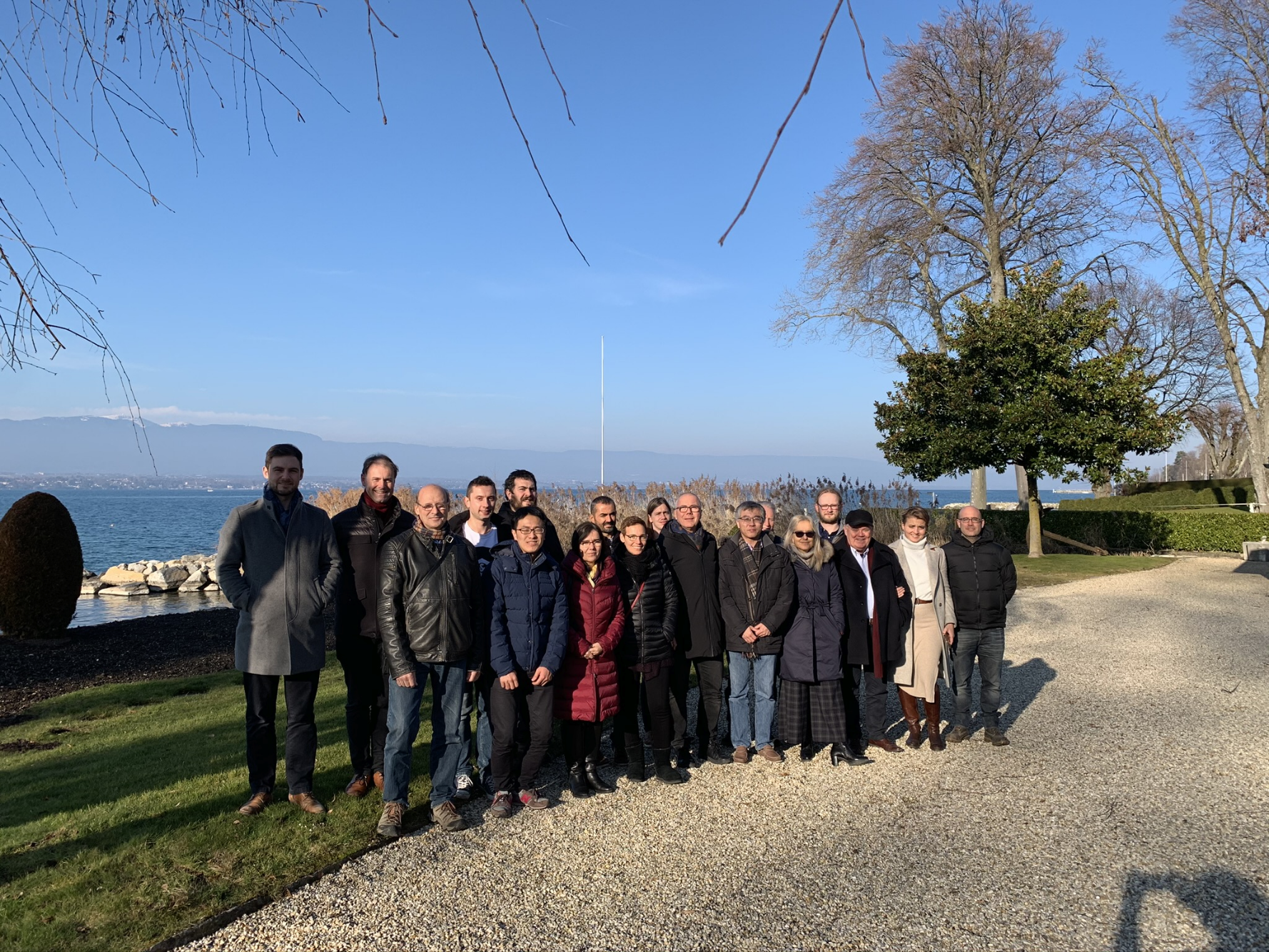
ACKNOWLEDGEMENTS
This project has received funding from the European Union's Horizon 2020 research and innovation programme under grant agreement No 862044.
We are grateful to Pierre Alexandre Thonet for the magnet design, to Carlo Petrone and Guy Deferne for the magnetic field measurements, and to P. Broulim and L. Pusman for designing the pixel board mechanics.
Contact: Xin Wu
DISCLAIMER: All views and opinions expressed on this site are those of the authors and do not necessarily reflect the official policy or position of any other agency, organization, employer or company. In particular the European Commission is not responsible for any use that may be made of the information hereby contained.
Created by Mercedes Paniccia
Mantained by Mercedes Paniccia (UNIGE) and Maura Graziani (INFN-Perugia)
This document was last modified .
